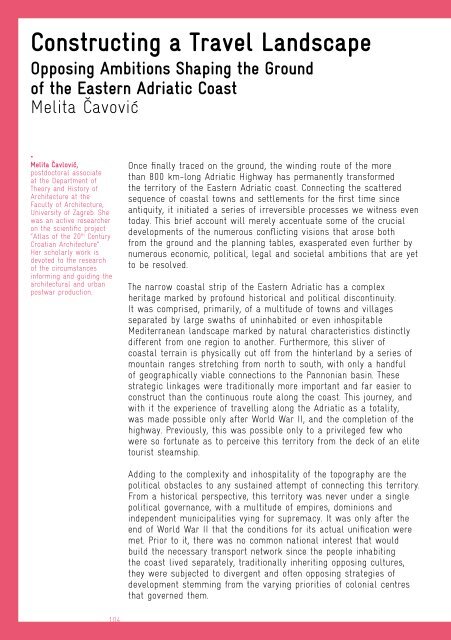Mapping the Croatian Coast
ISBN 978-3-86859-648-9
ISBN 978-3-86859-648-9
You also want an ePaper? Increase the reach of your titles
YUMPU automatically turns print PDFs into web optimized ePapers that Google loves.
Constructing a Travel Landscape<br />
Opposing Ambitions Shaping <strong>the</strong> Ground<br />
of <strong>the</strong> Eastern Adriatic <strong>Coast</strong><br />
Melita Čavović<br />
•<br />
Melita Čavlović,<br />
postdoctoral associate<br />
at <strong>the</strong> Department of<br />
Theory and History of<br />
Architecture at <strong>the</strong><br />
Faculty of Architecture,<br />
University of Zagreb. She<br />
was an active researcher<br />
on <strong>the</strong> scientific project<br />
“Atlas of <strong>the</strong> 20 th Century<br />
<strong>Croatian</strong> Architecture”.<br />
Her scholarly work is<br />
devoted to <strong>the</strong> research<br />
of <strong>the</strong> circumstances<br />
informing and guiding <strong>the</strong><br />
architectural and urban<br />
postwar production.<br />
Once finally traced on <strong>the</strong> ground, <strong>the</strong> winding route of <strong>the</strong> more<br />
than 800 km-long Adriatic Highway has permanently transformed<br />
<strong>the</strong> territory of <strong>the</strong> Eastern Adriatic coast. Connecting <strong>the</strong> scattered<br />
sequence of coastal towns and settlements for <strong>the</strong> first time since<br />
antiquity, it initiated a series of irreversible processes we witness even<br />
today. This brief account will merely accentuate some of <strong>the</strong> crucial<br />
developments of <strong>the</strong> numerous conflicting visions that arose both<br />
from <strong>the</strong> ground and <strong>the</strong> planning tables, exasperated even fur<strong>the</strong>r by<br />
numerous economic, political, legal and societal ambitions that are yet<br />
to be resolved.<br />
The narrow coastal strip of <strong>the</strong> Eastern Adriatic has a complex<br />
heritage marked by profound historical and political discontinuity.<br />
It was comprised, primarily, of a multitude of towns and villages<br />
separated by large swaths of uninhabited or even inhospitable<br />
Mediterranean landscape marked by natural characteristics distinctly<br />
different from one region to ano<strong>the</strong>r. Fur<strong>the</strong>rmore, this sliver of<br />
coastal terrain is physically cut off from <strong>the</strong> hinterland by a series of<br />
mountain ranges stretching from north to south, with only a handful<br />
of geographically viable connections to <strong>the</strong> Pannonian basin. These<br />
strategic linkages were traditionally more important and far easier to<br />
construct than <strong>the</strong> continuous route along <strong>the</strong> coast. This journey, and<br />
with it <strong>the</strong> experience of travelling along <strong>the</strong> Adriatic as a totality,<br />
was made possible only after World War II, and <strong>the</strong> completion of <strong>the</strong><br />
highway. Previously, this was possible only to a privileged few who<br />
were so fortunate as to perceive this territory from <strong>the</strong> deck of an elite<br />
tourist steamship.<br />
Adding to <strong>the</strong> complexity and inhospitality of <strong>the</strong> topography are <strong>the</strong><br />
political obstacles to any sustained attempt of connecting this territory.<br />
From a historical perspective, this territory was never under a single<br />
political governance, with a multitude of empires, dominions and<br />
independent municipalities vying for supremacy. It was only after <strong>the</strong><br />
end of World War II that <strong>the</strong> conditions for its actual unification were<br />
met. Prior to it, <strong>the</strong>re was no common national interest that would<br />
build <strong>the</strong> necessary transport network since <strong>the</strong> people inhabiting<br />
<strong>the</strong> coast lived separately, traditionally inheriting opposing cultures,<br />
<strong>the</strong>y were subjected to divergent and often opposing strategies of<br />
development stemming from <strong>the</strong> varying priorities of colonial centres<br />
that governed <strong>the</strong>m.<br />
104


















